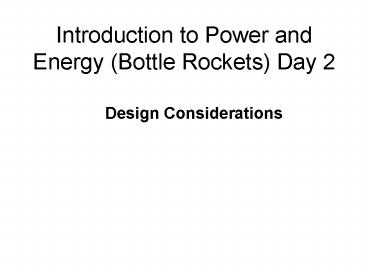Introduction to Power and Energy Bottle Rockets Day 2 - PowerPoint PPT Presentation
1 / 13
Title:
Introduction to Power and Energy Bottle Rockets Day 2
Description:
Your rocket will need to be designed in such a way that it is stable in flight. ... of a rocket is to make a cardboard cutout shaped like the silhouette of the ... – PowerPoint PPT presentation
Number of Views:92
Avg rating:3.0/5.0
Title: Introduction to Power and Energy Bottle Rockets Day 2
1
Introduction to Power and Energy (Bottle Rockets)
Day 2
- Design Considerations
2
Stability
- Your rocket will need to be designed in such a
way that it is stable in flight. This will
allow it to fly high and stay airborne longer.
3
Center of MassCenter of Pressure
- Weathervane example
4
Determining the Center of Mass (CM)
- The point at which the rocket balances. If you
were to tie a string around the rocket at its CM,
it would balance from the string horizontally.
5
Determining the Center of Pressure
- The CP exists only when air is flowing past the
moving rocket. I you were to attach a pivot and
then hold the rocket crossways into the wind by
that pivot, the wind forces on either side of the
CP are equal. - One method of approximating the CP of a rocket is
to make a cardboard cutout shaped like the
silhouette of the rocket, and then find the
cutout's balance point. This balance point
provides an approximation of the CP of the
rocket.
6
Nose Cone
- Rounded nose cones are more aerodynamic than
pointed ones. - The nose cone is often used to carry a payload
such as the recovery system.
7
Fins Design
- Fins add surface area to the rear of the rocket
which helps keep the nose of the rocket pointed
into the wind. - Similar to Nose cones, fins produce less drag
when they are rounded. They move the CP back
toward the rear of the rocket.
8
Relationship of CP to CM
- It is important that the CP is located toward the
tail of the rocket and the CM is located toward
the nose
9
Ways to adjust CP and CM
- Adding fins to a rocket. The larger the fins, the
further back the CP will be. - Adding weight to the nose cone section will help
move the CM toward the nose of the rocket.
10
Nozzle
- Arguments for the size of nozzle are given below
- A wide-open nozzle allows for a lot of thrust but
for a very short period of time. - Reduced nozzles don't give as much thrust but
they burn longer. Because of this low thrust
(i.e., slow launch speeds) you need to have a
rocket that is stable at slower speeds. - Launches with a reduced nozzle are slower, have a
less explosive launch, are safer in the event of
a tip over, and look cool. - A wide-open nozzle keeps launches fast and stable.
11
Fill Ratio
- The more water you put in the rocket, the longer
it will have thrust (Remember thrust exists until
the last drop of water is expelled). However,
the more water you put in, the heavier the rocket
will be, hampering its acceleration.
12
Pressure
- You should normally launch with about 100 psi.
The more pressure you use, the less stable the
flight will be.
13
Recovery system
- This could be a parachute, a ball in the cone or
other things. You invent it. - Go online to research. With any search engine,
search for water bottle rockets.































